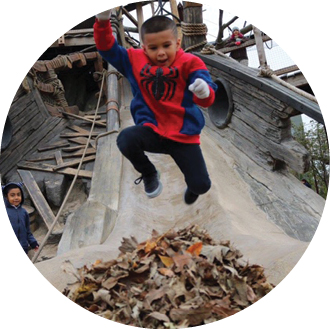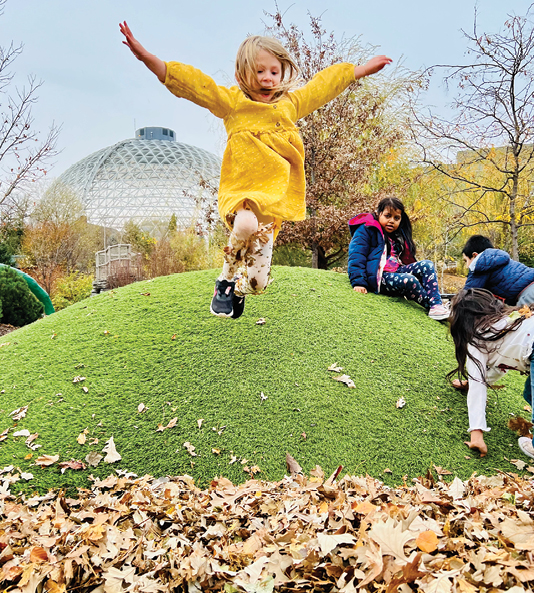Eliminate Barriers to Risk Taking in Outdoor Play

You are here
All children need daily, sustained opportunities to play outdoors, where they can learn about their bodies in space and use big muscle movements to climb, crawl, run, and jump. Outdoor play is part of developmentally appropriate practice, and the American Academy of Pediatrics recommends children spend 60 minutes daily working their large muscles. Research, however, continues to show an increase in indoor, sedentary activity. A 2020 report from the academy went so far as to recommend pediatricians write prescriptions for physical activity.
Outdoor play includes running and moving vigorously, climbing on equipment, and navigating uneven terrain. It also includes boisterous large motor activities like tag, tumbling, and pretend fighting. This physicality gets hearts pumping and blood flowing, both of which support cardiovascular and muscular fitness, bone health, and healthy weight.
Yet the benefits of outdoor play aren’t just physical. It also allows children to challenge themselves and become appraisers of risk. This, in turn, helps develop cognitive, social and emotional, and self-regulatory skills.
Meet Julian. He is full of energy, joy, and life. He never hesitates to try new things in Ms. Leah’s classroom—especially when they involve taking risks.
This brisk, bright, November day presents the perfect opportunity for Ms. Leah to offer her class of 5-year-olds a new way to explore risk taking in a space they have become familiar with: the playground at Omaha’s Henry Doorly Zoo and Aquarium. She has placed large piles of leaves around the space, including at the bottom of the tallest slide. Julian propels himself down the slide, using his arms to gain speed along the way. Before reaching the bottom, he quickly moves to his feet, bends his knees, swings his arms above his head, and yells “CANNONBALL!” as he tumbles into a leaf pile five times his size.
In this moment, Julian sets the tone for play. Almost every child wants to fly like him. As they play, the once massive leaf pile shrinks, and children use large motor movement to rebuild it. Calls for teamwork begin: “We need more leaves!” “Make it higher!” “HELP!”
As Julian runs to the top of the slide again, Alex scoops a beach ball-size pile of leaves into his arms, walks to the bottom of the slide, and waits. As Julian slides, Alex throws his leaves into the air, creating a perfectly timed leaf shower as his classmate soars into the pile of leaves below.
 Outdoor play environments such as parks, playgrounds, and community spaces are often familiar to children. As they grow in their comfort with these areas, their desire to test their limits and explore their capabilities grows. Yet early childhood educators often impose limits on risky play in an effort to promote safety. For example, they may not allow children to walk up the slide, even though this promotes the use of large muscle groups not activated when sliding down.
Outdoor play environments such as parks, playgrounds, and community spaces are often familiar to children. As they grow in their comfort with these areas, their desire to test their limits and explore their capabilities grows. Yet early childhood educators often impose limits on risky play in an effort to promote safety. For example, they may not allow children to walk up the slide, even though this promotes the use of large muscle groups not activated when sliding down.
While well-intentioned, imposing rigid rules on how children engage in the outdoors can lead to missed opportunities for development in multiple domains. (For more about this, see “Climbing Trees, Risk, and Relationships: Using Nature to Empower Children,” by Ron Grady, in the Fall 2021 issue of Teaching Young Children.) As they climb up slides, jump over equipment, and chase each other, children learn to assess risk, devise a plan, and take action. They make decisions and problem solve when they face a challenging moment. They also learn to process and navigate their feelings and emotions.These actions build resilience as children experience success or challenges. (See “When to Intervene” below for guidance on assessing when a play situation might be too risky.)
Strategies for Risk Taking Outdoors
To support children in their outdoor play, early childhood educators can reframe their views of risk taking by acknowledging the developmental benefits of taking risks and working to remove barriers and boundaries that limit open, free play. Following are some strategies for fostering risk taking.
Examine Existing Beliefs
Educators’ personal experiences and perceptions inform their actions and reactions to a child engaged in risky play. Because Ms. Leah believes in the power of taking risks, she purposefully plans opportunities for children to play in environments that foster it. When Julian leaps into that giant pile of leaves, Ms. Leah knows she achieved her goal.
To gauge how they avoid or champion risk taking, educators can reflect on their own beliefs by asking questions such as
- Am I a risk taker?
- What worries me about taking risks?
- What excites me about taking risks?
- What childhood memories do I have of taking a risk?
This introspection can help them determine how to foster risk taking while keeping safety in mind. For example, instead of stopping risky play, an educator might pose questions: How are children feeling about the play situation? Do they have a plan for evaluating its risks? As educators reflect, they can gauge the limitations they may place on risk taking and play.
Get to Know the Child and Environment
Teachers and children are familiar with their programs’ outdoor play spaces. Thanks to this familiarity, educators can evaluate the terrain and the safety of each structure and piece of equipment, asking
- How might each child navigate the space?
- What hurdles may they face?
- What kind of support may I need to offer?
- When should I offer it?
They also must know the children in their care. When Ms. Leah evaluates her play space, she carefully considers each child in her class. Knowing they will approach the tallest slide in many different ways, she can determine how to empower each child to make their own decisions about risk taking.
Become an Observer
Outdoor spaces are designed to foster running, jumping, swinging, climbing, and moving over uneven terrain. As children move, early childhood educators should pay attention to their fine and large motor abilities, taking note when a child hesitates or pauses while engaged in a task or with others. Through observation, teachers will develop an understanding of a child’s ability to appraise and respond to risk.
Consider how the environment challenges children. Ms. Leah knows Julian is well versed in appraising and taking risks. She is not worried when she sees how fast he goes down the slide or how high he jumps because she has observed his ability to navigate risk and safely control his body. Alex, on the other hand, is not as comfortable taking the same risks as Julian. Such careful attention will help educators determine when to step in and when to provide proximal guidance for a child to analyze risk.
Model and Encourage
 Children grow in their ability to appraise risk by observing others’ play and movement. Educators can support risk taking by engaging in it themselves and expressing their thoughts verbally. This models the internal dialogue that occurs when assessing risks and challenges.
Children grow in their ability to appraise risk by observing others’ play and movement. Educators can support risk taking by engaging in it themselves and expressing their thoughts verbally. This models the internal dialogue that occurs when assessing risks and challenges.
Ms. Leah, for instance, introduces children to the slide by modeling how to climb and position herself on it. She then proceeds to slide down. Throughout this process, she verbalizes her thinking and emotions:
- “Wow, that looks really high, but I’ll try a few steps and see how I feel.”
- “I’m afraid the slide might be too fast for me, and I’ll get hurt. Maybe I’ll try the smaller one first.”
Such modeling can help children learn self-regulation as they examine their thoughts and feelings and determine their next steps.
When to Intervene
While acknowledging that risk taking is developmentally appropriate and a healthy part of early childhood, educators often find themselves in a paradox: they want to foster risky play and urge children to step out of their comfort zones, but they also must ensure safety. Knowing when to intervene can be challenging.
Because teachers are keen observers of children, they should insert themselves in a risky play scenario if
- the level of risk could lead to serious injury
- a child demonstrates emotional distress or fear
- the structure or environment is hazardous (ice on play surfaces, broken glass, construction)
Conclusion
While not every child will approach risk taking with the same enthusiasm as Julian, it’s up to educators to foster risk taking in safe and meaningful ways that are responsive to each child’s individual strengths and needs. By encouraging children to explore their world and use problem-solving skills to appraise risk, educators foster developmentally appropriate big body movement and outdoor play.
Photographs: courtesy of Leah Litz
Copyright © 2023 by the National Association for the Education of Young Children. See permissions and reprints online at NAEYC.org/resources/permissions.

 This article supports the following NAEYC Early Learning Programs standards and topics
This article supports the following NAEYC Early Learning Programs standards and topics
Standard 2: Curriculum
2C: Physical Development
Standard 3: Teaching
3G: Using Instructions to Deepen a Child’s Understanding and Build Their Skills and Knowledge
Standard 4: Assessment of Child Progress
4D: Adapting Curriculum, Individualizing Teaching, and Informing
Program Development
Amanda Steiner, EdD, is an assistant professor of elementary education at the University of Nebraska at Omaha.
Anne Karabon, PhD, is the Thompson director of the School of Education, Counseling, and Human Development and ECE faculty at South Dakota State University-Brookings, SD.
Leah Litz, MEd, is the zoo kindergarten teacher with Omaha Public Schools and Omaha’s Henry Doorly Zoo and Aquarium.
